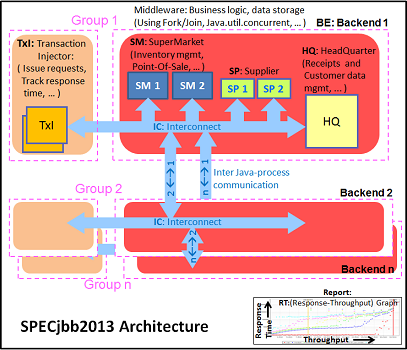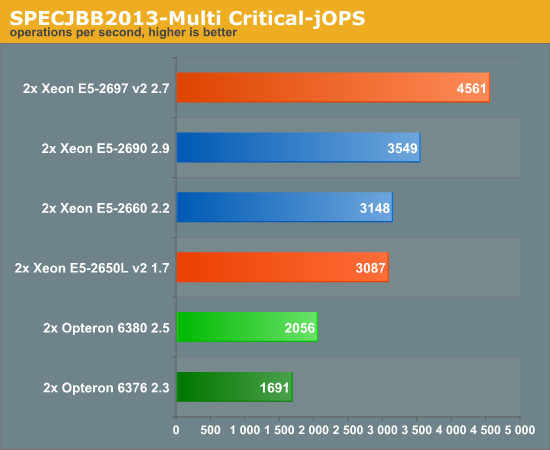Intel's Xeon E5-2600 V2: 12-core Ivy Bridge EP for Servers
by Johan De Gelas on September 17, 2013 12:00 AM ESTJava Server Performance
The SPECjbb 2013 benchmark is based on a "usage model based on a world-wide supermarket company with an IT infrastructure that handles a mix of point-of-sale requests, online purchases and data-mining operations". It uses the latest Java 7 features and makes use of XML, compressed communication and messaging with security.

We tested with four groups of transaction injectors and backends. We applied a relatively basic tuning to mimic real world use.
"-server -Xmx4G -Xms4G -Xmn1G -XX:+AggressiveOpts -XX:+UseLargePages-server -Xmx4G -Xms4G -Xmn1G -XX:+AggressiveOpts -XX:+UseLargePages"
With these settings, the benchmark takes about 43GB of RAM. The first metric is basically maximum throughput.

The newest Xeon E5 2697 v2 delivers 33% better performance. The Opteron 6380 needs a 50% clock advantage to stay ahead of the 10-core Xeon E5. This illustrates how large the gap is between the Opterons and even the midrange Xeons. A 10-core Xeon E5-2660 V2 at 2.2GHz costs a bit more than the Opteron 6380 but will deliver a significantely better performance per watt, considering the very low 95W TDP.
The Critical-jOPS metric, is a throughput metric under response time constraint.

We have to admit we have our doubts. The Critical-jOPS measurements do not seem to be very repeateable and it is not completely clear how it is calculated. However, it confirms earlier measurements of our own that the Xeons are better at responding quickly at a given throughput. Again, the new Xeon 2697 v2 performs about 30% better than the Xeon E5 2690.










70 Comments
View All Comments
JohanAnandtech - Friday, September 20, 2013 - link
I have to admit were are new to SPECjbb 2013. Any suggestions for the JVM tunings to reduce the GC latency?mking21 - Wednesday, September 18, 2013 - link
Surely its more interesting to see if the 12 core is faster than the 10 and 8 core V2s.Its not obvious to me that the 12 Core can out perform the 2687w v2 in real world measures rather than in synthetic benchmarks. The higher sustained turbo clock is really going to be hard to beat.
JohanAnandtech - Wednesday, September 18, 2013 - link
There will be a follow-up, with more energy measurements, and this looks like a very interesting angle too. However, do know that the maximum Turbo does not happen a lot. In case of the 2697v2, we mostly saw 3 GHz, hardly anything more.mking21 - Wednesday, September 18, 2013 - link
Yes based on bin specs 3Ghz is what I would expect from 2697v2 if more than 6 or more cores are in use. 5 or more cores on 2687wv2 will run @ 3.6Ghz. While 2690v2 will run 3.3Ghz with 4 or more cores. So flat out the 12 core will be faster than 10 core will be faster than 8 core - but in reality hard to run these flat out with real-world tasks, so usually faster clock wins. Look forward to u sharing some comparative benchmarks.psyq321 - Thursday, September 19, 2013 - link
3 GHz is the maximum all-core turbo for 2697 v2.You are probably seeing 3 GHz because several cores are in use and 100% utilized.
JohanAnandtech - Friday, September 20, 2013 - link
With one thread, the CPU ran at 3.4 GHz but only for very brief periods (almost unnoticeable).polyzp - Saturday, September 21, 2013 - link
AMD's Kaveri IGPU absolutley destroys intel iris 5200! Look at the first benchmarks ever leaked! +500% :OAMDFX .blogspot.com
Jajo - Tuesday, October 1, 2013 - link
E5-2697v2 vs. E5-2690 +30% performance @ +50% cores? I am a bit disappointed. Don't get me wrong, I am aware of the 200 Mhz difference and the overall performance per watt ratio is great but I noticed something similar with the last generation (X5690 vs. E5-2690).There are still some single threaded applications out there and yes, there is a turbo. But it won't be aggressive on an averagely loaded ESXi server which might host VMs with single threaded applications.
I somehow do not like this development, my guess is that the Hex- or Octacore CPUs with higher clocks are still a better choice for virtualization in such a scenario.
Just my 2 cents
Chrisrodinis - Wednesday, October 23, 2013 - link
Here is an easy to understand, hands on video explaining how to upgrade your server by installing an Intel E5 2600 V2 processor: http://www.youtube.com/watch?v=duzrULLtonMDileepB - Thursday, October 31, 2013 - link
I think 12 core diagram and description are incorrect! The mainstream die is indeed a 10 core die with 25 MB L3 that most skus are derived from. But the second die is actually a 15 core die with 37.5 MB. I am guessing (I know I am right :-))That they put half of the 10 core section with its QPIs and memory controllers, 5 cores and 12.5 MB L3 on top and connected the 2 sections using an internal QPI. From the outside it looks like a 15 core part, currently sold as a 12 core part only. A full 15 core sku would require too much power well above the 130W TDP that current platforms are designed for. They might sell the 15 core part to high end HPC customers like Cray! The 12 core sku should have roughly 50% higher die area than the 10 core die!